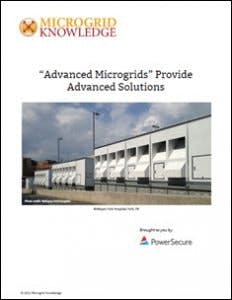A new white paper from PowerSecure looks at how advanced microgrids, designed with an understanding of the dynamics and evolution of the modern power grid, can create extraordinary value for both utilities and consumers.
Get the full report.
Microgrids are often thought of as a form of backup power or a boutique renewable energy project. But, according to the paper, “both of those views miss the mark and obscure the true benefits and value that can be derived from a microgrid, particularly an ‘advanced microgrid.'”
To understand the benefits of an advanced microgrid, the author explains that we first must understand its commercial viability. The author goes on to explain that electrical power demand fluctuates throughout the day and by season. If not properly managed, these fluctuations can create issues on the grid. These demand fluctuations are typically illustrated with accumulated demand curves (ADC) and duck curves. Spikes in electricity demand are easily seen in the ADC curves, while the duck curve “demonstrates the growing challenge utilities and grid operators face in the morning and evening when systems with a significant amount of solar power face an increase and rapid decrease in solar generation.”
“An advanced microgrid provides resiliency, sustainability and commercial viability. Most importantly, an advanced microgrid provides value to both the local utility and to the microgrid customer.” — PowerSecure, “‘Advanced Microgrids’ Provide Advanced Solutions”
Once you understand the dynamics of the electricity market that are illustrated in the ADC and duck curve, the true value of an advanced microgrid is revealed. “From a utility perspective, an advanced microgrid can provide multiple functions,” according to the paper. “When renewable resources such as solar power are overproducing, an advanced microgrid can provide load by soaking up excess energy and using it to charge energy storage devices.” That excess energy can then satisfy sporadic and sudden demand from consumers. This bridging of the gap between utilities and consumers improves the economics of the grid and reduces carbon emissions.
In this video, Mark Martyak of PowerSecure explains some of the many benefits of a hybrid, or advanced microgrid.The white paper provides three mini case studies of advanced microgrids. The practical application examples include Alabama’s Neighborhood of the Future, the Marine Corps Air Station in Yuma, Arizona, and Wellspan York Hospital in Pennsylvania.
Download the full report from PowerSecure to learn more about advanced microgrids.








